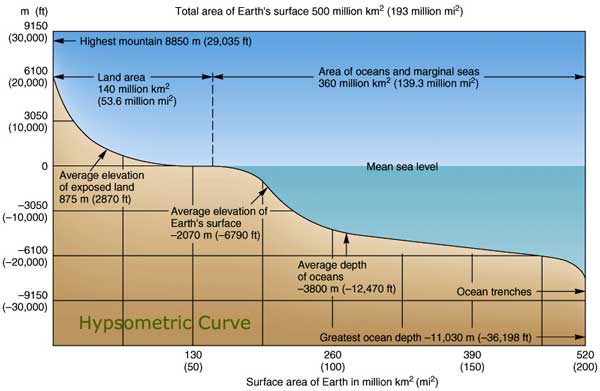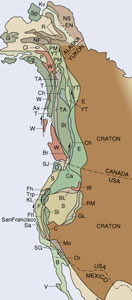THE NATURAL ENVIRONMENT
Geography 101
ToC
MOUNTAINS
Crust
Folding
Earthquakes
Volcanoes
Hawai'i
The Crust
|
|
BOX 1 |
In the previous chapter, we discussed our planet's layered structure and how heat flowing out from Earth's interior drives lithospheric plate motion and mantle plumes at hot spots. We continue that theme by more carefully examining endogenic processes and the landforms they create.
The density difference between continental and ocean crust produces a unique feature on planet Earth: two distinct elevation patterns with ocean bottoms averaging about 5 kilometers (3 miles) lower than continental surfaces. This difference is illustrated in a hypsometric curve, which shows the accumulated area of the entire Earth's solid surface above each elevation and in relation to sea level. This sounds confusing, but if you look at the graph below, it should make more sense.

Oceans bottoms are lower because oceanic crust is thinner and denser than continental crust. Notice the sharp drop in the curve near the average elevation of Earth's surface (which is below sea level). This represents a clear separation between the two crustal types. Ocean crust, which covers most of the planet's surface, lies mostly between about 3 and 5 kilometers (2 and 3 miles) depth, while continental crust, including the offshore continental shelves, averages less than 1 kilometer (0.6 miles) above sea level.

 Unlike
oceanic crust, most continental crust has been around
for billions of years. It is so light that it "floats" on the
denser rock beneath and resists being pushed down into the mantle for
remelting.
It has been crushed, folded, broken, moved, tumbled and otherwise abused,
but it is still around.
Billions of years of weathering and erosion have bared areas of ancient
original rock, exposing continental shields.
Continental shields make up the majority of the continent of Africa
and
substantial portions of South America, Australia, Asia, and North America.
Earth's oldest rocks have been found in these venerable formations.
The oldest true rocks, intact aggregates of minerals, date to about 4 billion years old. The oldest individual mineral, a fragment of zircon found in Western Australia, dated to 4.374 billion years old.
Unlike
oceanic crust, most continental crust has been around
for billions of years. It is so light that it "floats" on the
denser rock beneath and resists being pushed down into the mantle for
remelting.
It has been crushed, folded, broken, moved, tumbled and otherwise abused,
but it is still around.
Billions of years of weathering and erosion have bared areas of ancient
original rock, exposing continental shields.
Continental shields make up the majority of the continent of Africa
and
substantial portions of South America, Australia, Asia, and North America.
Earth's oldest rocks have been found in these venerable formations.
The oldest true rocks, intact aggregates of minerals, date to about 4 billion years old. The oldest individual mineral, a fragment of zircon found in Western Australia, dated to 4.374 billion years old.
 While
most continental crust has been around a long, long time, new continental
crust does occasionally form. The westward movement
of the North American plate, for example, has scraped up a band of ancient
islands, coral reefs, chunks of ocean floor and other debris along the
western
edge
of the plate. These additions to the old original continent are called
terranes. The different colors in the diagram show different
accretions of material over time.
While
most continental crust has been around a long, long time, new continental
crust does occasionally form. The westward movement
of the North American plate, for example, has scraped up a band of ancient
islands, coral reefs, chunks of ocean floor and other debris along the
western
edge
of the plate. These additions to the old original continent are called
terranes. The different colors in the diagram show different
accretions of material over time.
While terranes stand out on geologic maps, a casual observer on the ground could not tell these recently accreted mountains from any other mountains. The Wrangell mountains, shown in the photograph, for example, are composed of the plastered together remnants of an ancient island arc that used to reside near the equator.
The life of oceanic crust is less exciting. It forms at areas of sea floor spreading, moves with the plates, and subducts back into the mantle to be remelted. As a result, it has very little geologic history compared to continental crust. The oldest oceanic crust known, found in the Western Pacific, dates back only 280 million years.